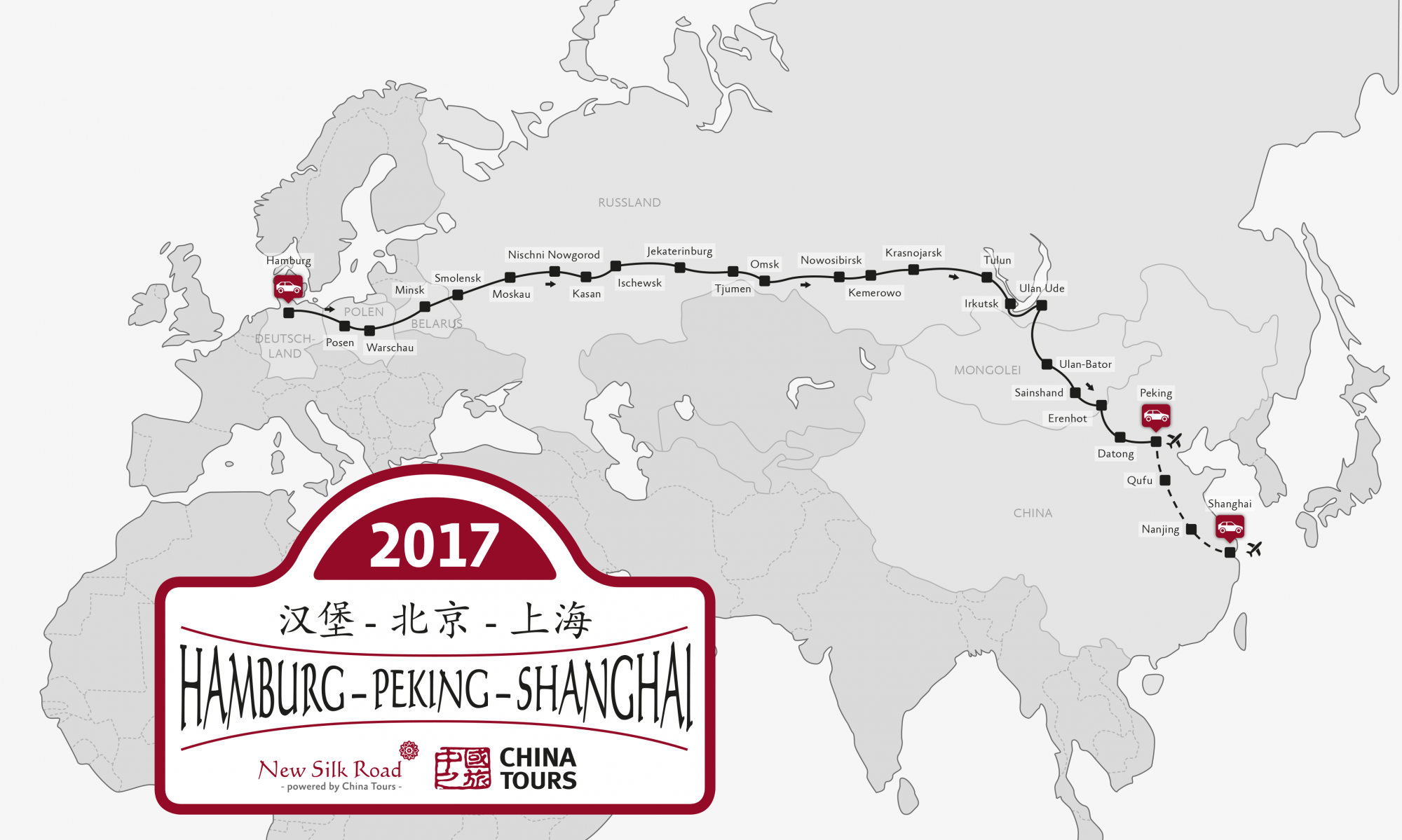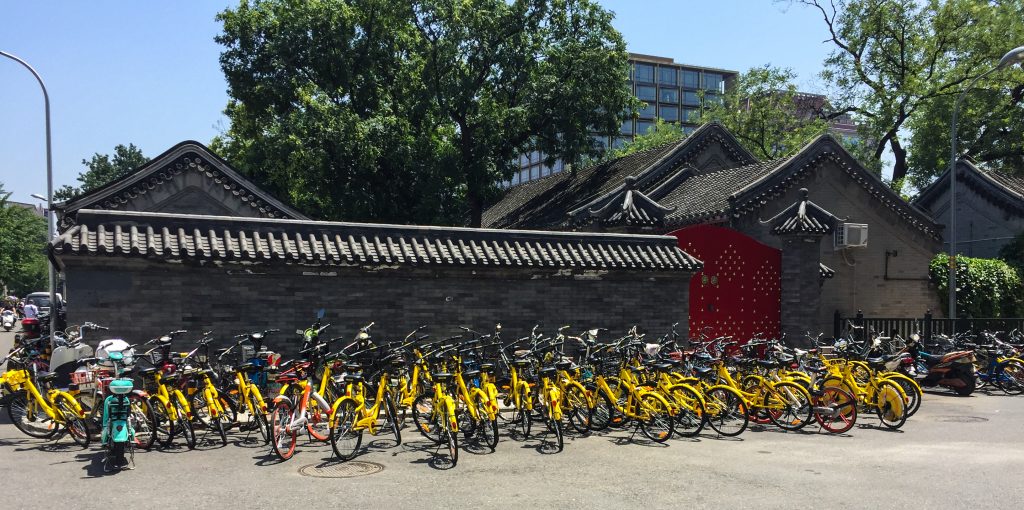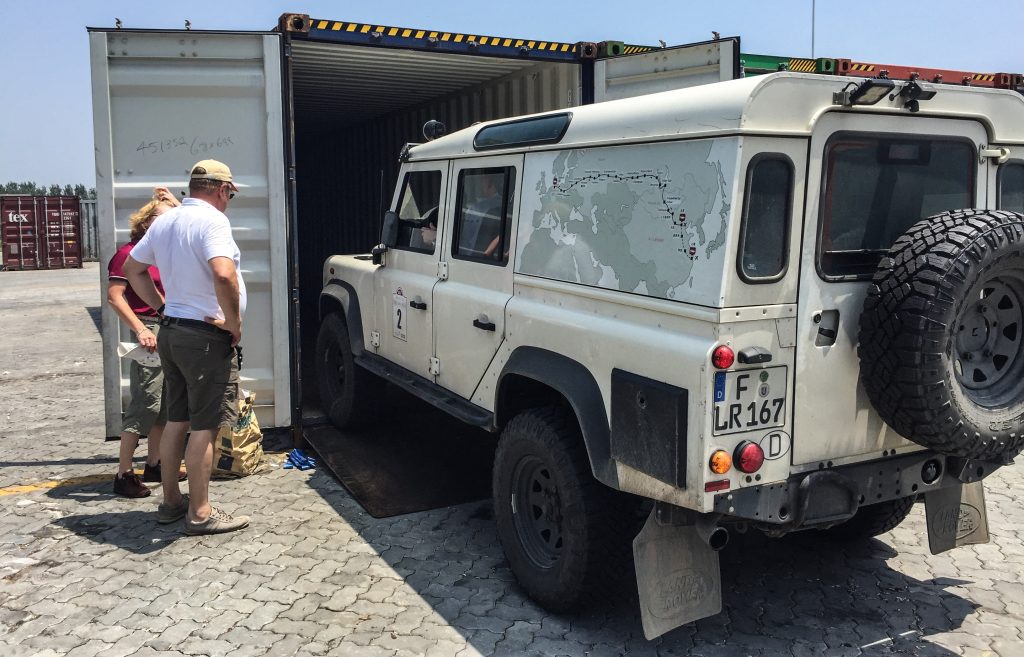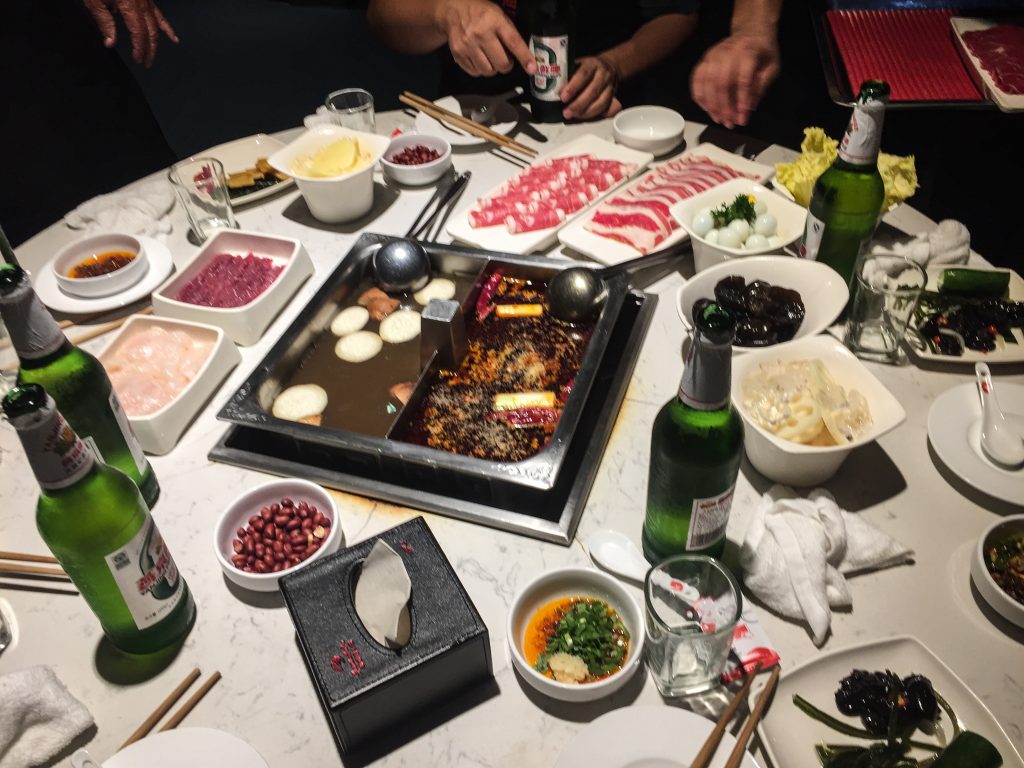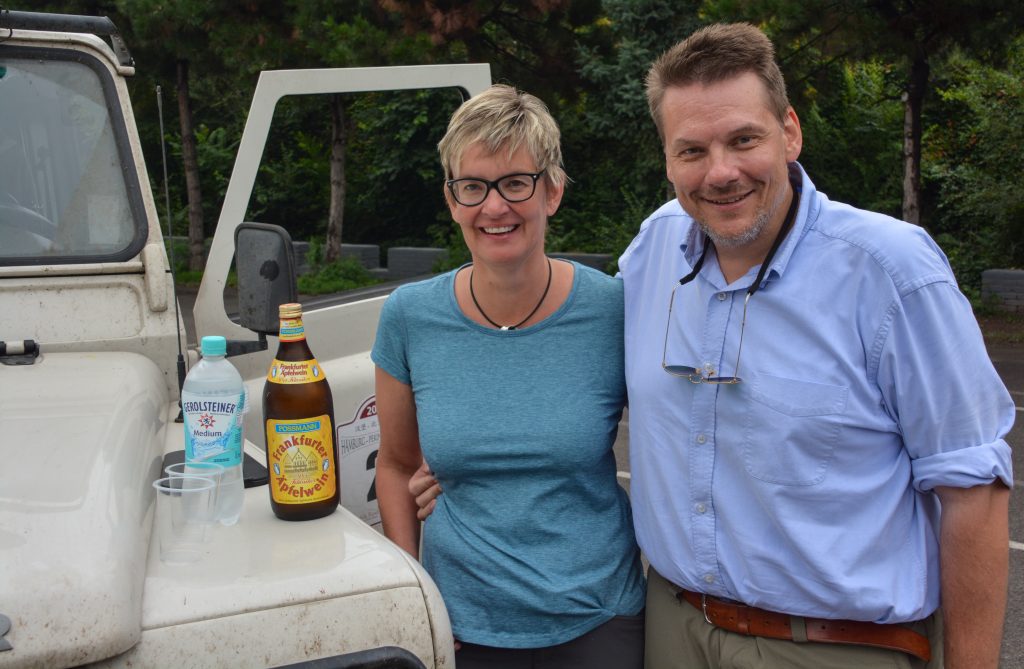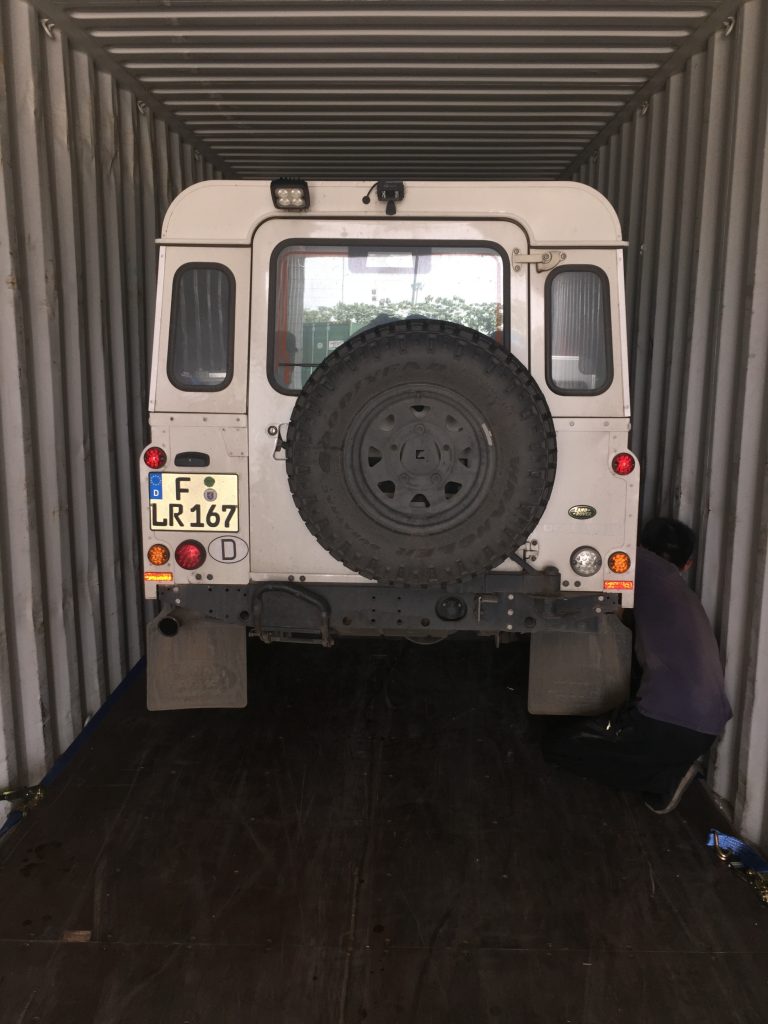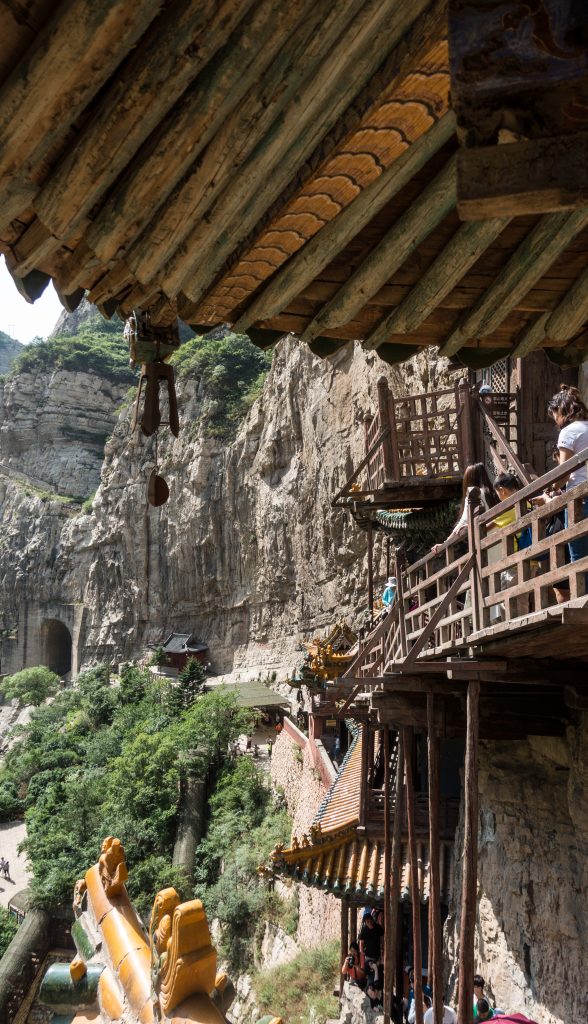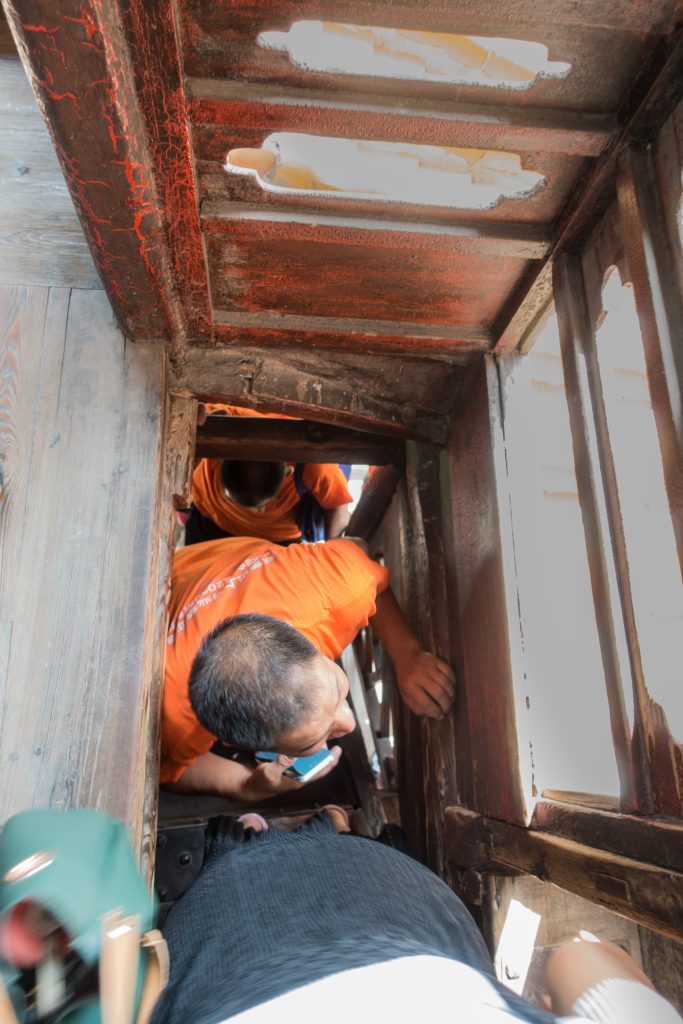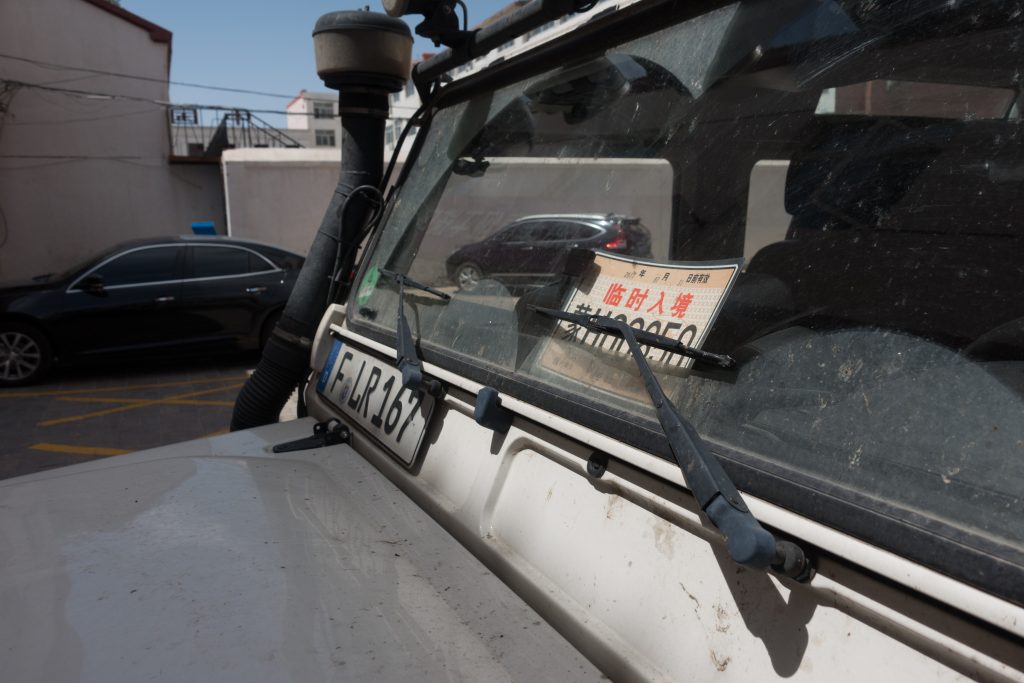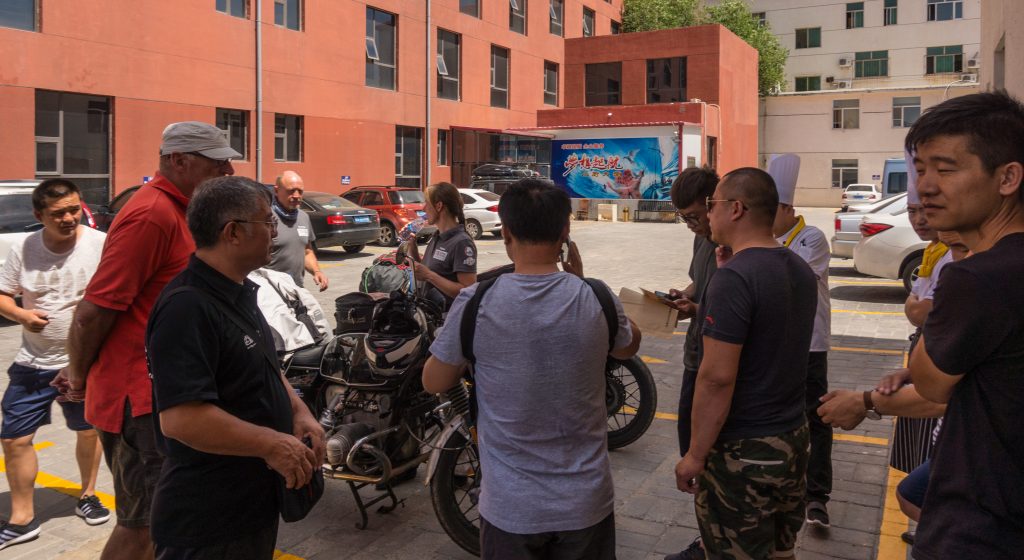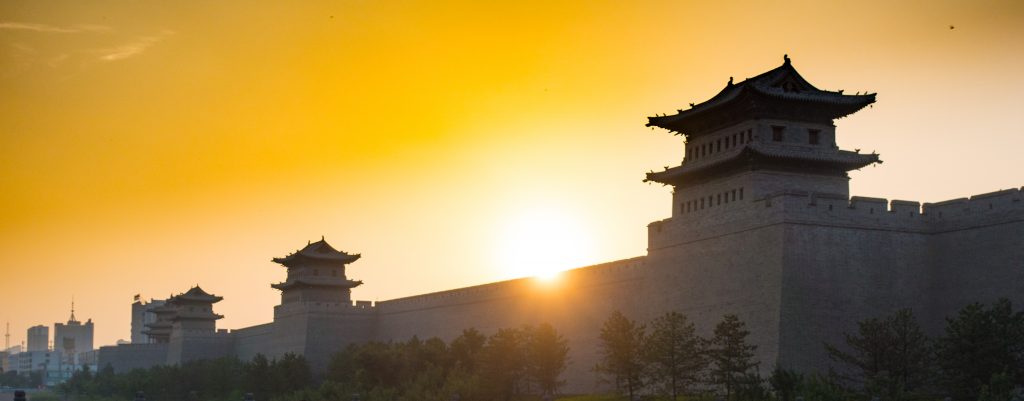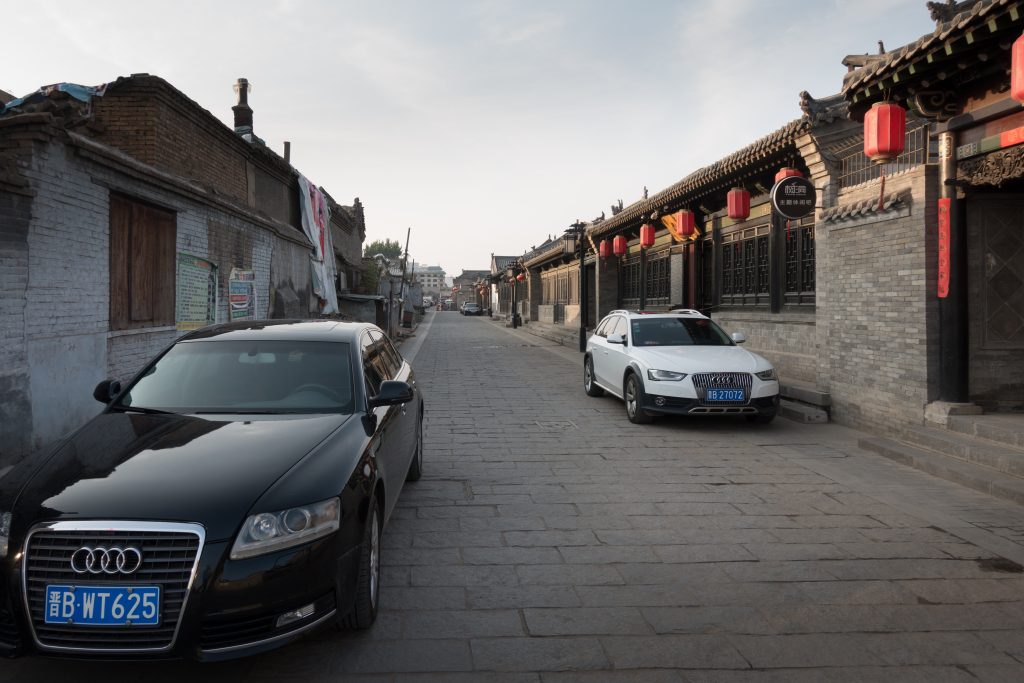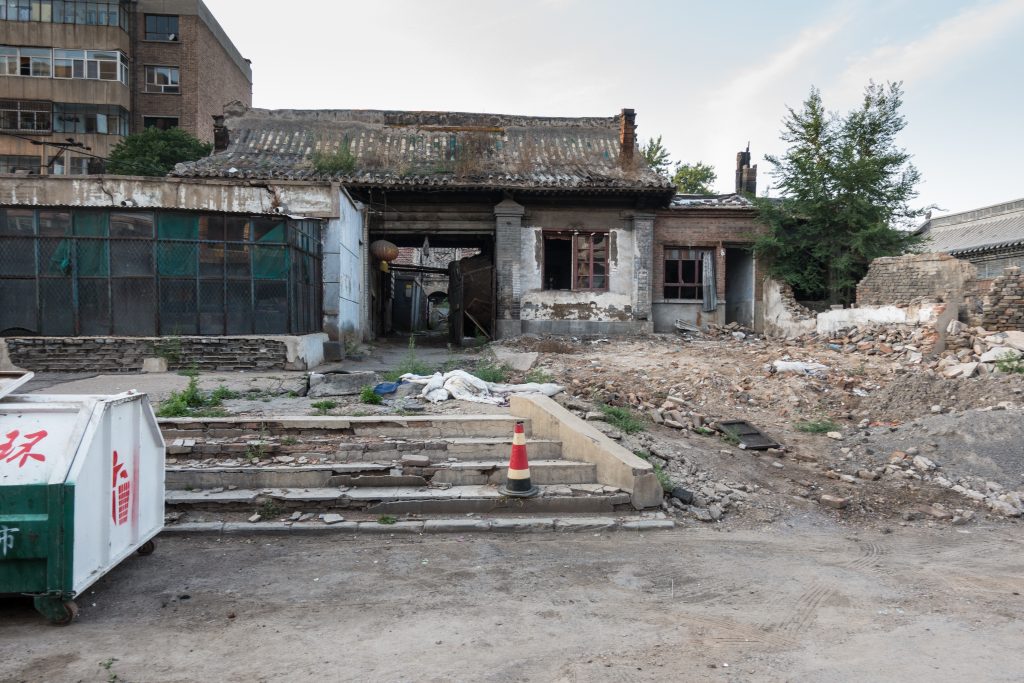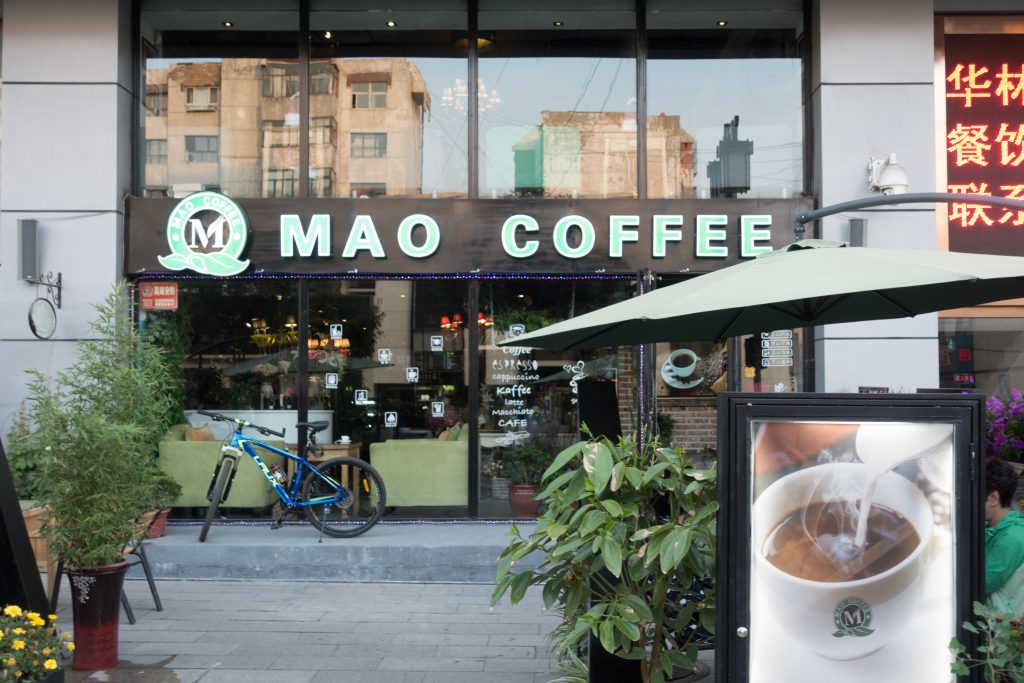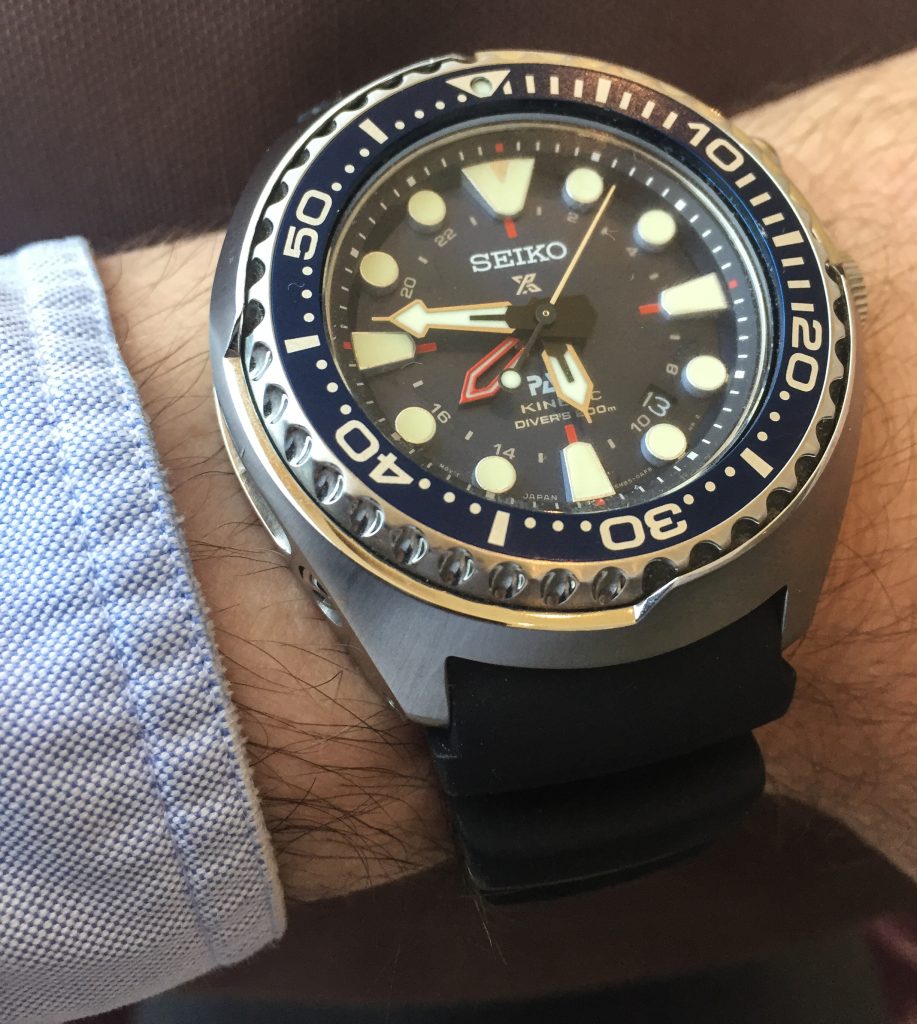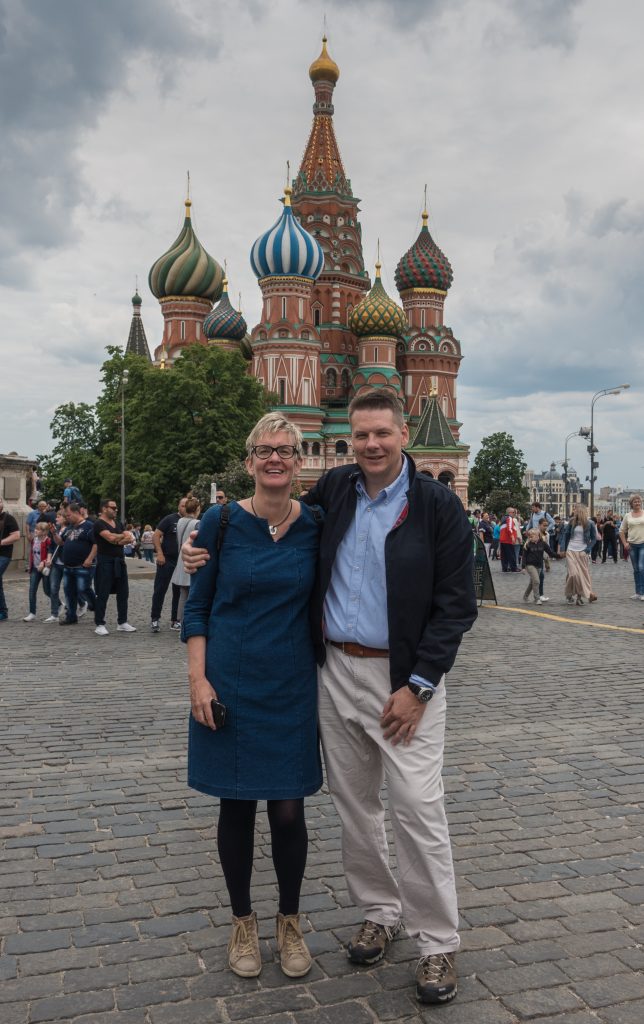
Ich habe mich entschlossen die Zusammenfassung und wichtigsten Punkte als FAQ zu gestalten. Entweder liest man es komplett oder pickt sich die Fragen heraus, die einen interessieren.
Zum Anfang der Story geht es hier: Das Team
Bitte meldet Euch mit weiteren Frage. Die kann ich dann hier integrieren.
F: War die Reise anstrengend?
A: Darauf gibt es keine eindeutige Antwort.
Nein, die Reise war im Grunde nicht anstrengend im Sinne einer körperlichen Belastung, von Krisen und Streß. Hätte es aber sehr schnell werden können, wenn irgendetwas Ernstes mit dem Auto oder der Gesundheit passiert wäre. Klar, auch und gerade in solchen Fällen hätte der Reiseveranstalter sicher intensiv unterstützt, aber mit Urlaub hätte das dann nichts mehr zu tun gehabt.
Ja, weil man dauernd sehr konzentriert Auto fahren musste und der Terminplan nicht wirklich vollgestopft, aber doch gedrängt war. Wir haben die Kilometerleistung eines normalen Autojahres in etwas mehr als einem Monat abgespult – über viele schlechte Strassen, in ständiger Bedrohung durch ziemlich viele Verrückte und in ziemlichen wilden Städten, wie Moskau, Ulan Bator oder Peking. Zeit zum begrenzten Ausruhen hätte es nur dann gegeben, wenn man sich auf die reine Fahrt konzentriert hätte. Aber wenn man von den Städten auch etwas sehen wollte, dann hatte man wirklich kaum Freizeit im Sinne von Erholung. On top kam dann auch noch das Blog, das jede Minute der verbliebenen Zeit füllte.
Je nach eigener Risikobereitschaft können einen auch die vielfältigen, nicht unbedingt eintretenden Risiken stressen. Totalverlust des Fahrzeugs, keine ausreichende Gesundheitsversorgung, Opfer von Kriminalität. Wenn ma an so etwas dauernd denken muss, dann ist eine solche Reise sehr anstrengend.
F: Hat die Reise die Erwartungen erfüllt?
A: Darauf gibt es zwei Antworten. Die Organisation war mit Ausnahme sehr weniger, kleinerer Punkte perfekt, ja fast schon zu perfekt. Nichts ging wirklich schief, nichts ist ausgefallen, alles lief wie ein Uhrwerk. Die Landschaft und Strecke hätte reizvoller oder besser abwechslungsreicher sein können. Mehr als zwei Wochen von Weißrussland bis zum Baikalsee Wald, Sumpf und Grasland wird dann irgendwann doch einmal langweilig.
F: Welche Highlights gab es?
A: Das grosse Highlight war natürlich, dass wir es bis Peking geschafft haben. Auch wenn man auf der Stecke manchmal denkt, dass halb Westeuropa in Sibirien ‘rumkurvt, sind es nüchtern betrachtet natürlich nicht viele Touristen, die sich eine solche Reise zutrauen, Lust dazu haben, finanziell leisten können und/oder wollen und es dann auch wirklich in die Tat umsetzen. Und spätestens hinter dem Baikalsee und erst recht in China ist man dann doch sehr alleine als Langnase.
Darüber hinaus waren es häufig die kleineren Siege über Sprachschwierigkeiten, die Unkenntnis von lokalen Gegebenheiten, Grenzen und kleineren Herausforderungen rund um das eigene Auto oder die Unterstützung anderer, z.B. bei der Navigation.
Landschaftlich war es – auch wenn es dann irgendwann einmal zu viel wurde – diese traumhafte Komposition aus Wald, Wiese und Sumpf in Sibirien und die Steppe in der Mongolei.
F: Was waren die Flops?
A: Da gab es nicht viel. Die Vorbereitung auf oder Begleitung durch die Grenzen, hier insbesondere Russland/Mongolei und Mongolei/China wäre zu nennen. Wenn man uns sagt, dass auf mongolischer Seite der Reiseführer in der Grenze auf uns wartet und uns unterstützt, dann wäre es klasse, wenn das auch so ist. Geht das aus irgendwelchen Gründen nicht, dann hätte ich wenigstens eine Information darüber, welche Schritte zu durchlaufen sind, was die wichtigen Stempel und Dokumente sind, die man braucht, was man sonst braucht, ggfs. eine Erklärung der auszufüllenden Zettel etc.
Letztlich waren alle Übertritte problemlos, wenn auch zeitaufwändig und – zumindest für mich – nervend, weil ich mich mit dieser Art von Kontrollverlust recht schwer tue.
Ferner gab es ab Moskau eine kleine Navigationskrise, von der wir zwar nicht betroffen waren, weil völlig überversorgt mit eigenen Tools, aber einige Teams fanden die Aussicht, nur noch per „Bleib auf der Linie“ zu navigieren, insbesondere in den Städten nicht wirklich verlockend. Da gab es einen kleinen Aufstand, der ja auch schnell Wirkung zeigte.
Und das war es dann auch schon.
F: Wie waren die Hotels?
A: Es gab kein einziges Hotel, in dem ich den dringenden Wunsch nach einem anderen Hotel gehabt hätte. Klar, manchmal hätte es vielleicht am gleichen Ort eine bessere Kategorie gegeben, aber zum einen muss der Veranstalter natürlich auch die Kalkulation im Auge behalten, zum anderen müssen die Hotels mit Blick auf die Autos auch geeignet sein – entweder indem sie sowieso einen grossen Parkplatz oder eine Garage haben oder indem sie Willens sind, das Problem mit etwas Kreativität zu lösen. In dem Zusammenhang – ich muß es leider noch einmal erwähnen – war das Hotel Peking in Moskau ein absoluter Totalausfall, denn die hatten einen halb leeren Hinterhof, auf dem man mit geringstem Willen locker eine Lösung hätte finden können. Für mich deshalb klar auf der schwarzen Liste. Das es auch anders geht, haben wir in Datong und auch Peking gesehen. Auch da hat eine 5-Sterne Fairmont sehr gerne die Chance genutzt und unsere Autos direkt in der Einfahrt platziert.
F: Wie war die Verpflegung?
A: Sagen wir so: Die Portionsgrößen in Belarus und Russland kamen mir sehr entgegen, weil ich keinesfalls während des Urlaubs zunehmen wollte, idealerweise sogar etwas abnehmen. Es gibt Mitreisende, die haben es sehr viel undiplomatischer beschrieben. Aber mal ehrlich: Hätte mir jemand im Vorfeld gesagt, wie die Verpflegung ist, ich wäre begeistert gewesen – mit all den Vorurteilen über Russland und Sibirien im Kopf: Eintöpfe mit sehnigem und fettigem Fleisch, verkochten Kartoffeln und Gemüse. Aber weit gefehlt. Die Küche war immer sehr klar, teilweise sogar leicht, nur leider etwas eintönig und … wenig. Als uns in Nowosibirsk als Hauptgang ein Teller mit zwei Gabeln Nudeln serviert wurde, dachte ich kurz mal an eine Beschwerde. Ein Blick auf meine Taille hat das dann aber sehr schnell verhindert…
Außerdem war die ständige Verpflegung in den jeweiligen Hotels sehr einfaltslos. Sowohl bzgl. des Essens als auch des Ambientes. Es gibt sicher dafür Gründe (man braucht jeweils einen kleinen Bus oder muß Taxis organisieren, sofern die Restaurants weiter weg liegen), aber der Hauptgrund erschien mir, dass wir seit längerem die ersten auf dieser Route waren und beim Scouting kein Schwerpunkt auf die Kulinarik gelegt wurde (wäre Han nicht passiert ;-).
In der Mongolei war das Essen überraschend gut, aber wir waren zu kurz da, um einen wirklichen Eindruck zu bekommen.
Die Küche in China war erste Sahne. Ich ziehe die Thaiküche normalerweise der chinesischen Küche ganz klar vor, aber die eine Woche hat uns Han gezeigt, dass auch Chinesen wirklich ganz ausgezeichnet kochen können. Top.
F: Wie waren die Reisebegleiter?
A: Viel Licht, sehr, sehr wenig Schatten.
Alla und Arthur waren großartig. Ständig im Hintergrund verfügbar, immer hilfsbereit, nach wenigen Tagen sehr gut wissend, wer was selbst machen kann oder wer auch mal etwas mehr Unterstützung braucht. Man hat eigentlich nicht gemerkt, dass Arthur ständig die Motorradfahrer bei Ersatzteilsuche oder Reparatur unterstützen musste und Alla noch Scouting-Aufgaben hatte.
Tugsuu war auf der touristischen Seite gut, aber er war die vielen starken Charaktere, die man nicht einfach durch einen gemeinsam genutzten Bus in den Griff bekommt und beaufsichtigen kann, sondern die aufgrund der eigenen Autos machen können, was sie wollen, nicht gewohnt. So hätte er merken müssen, dass wirklich niemand Lust auf das Mittagessen direkt nach dem Grenzübertritt hatte (übrigens das mit Abstand schlechteste Essen der Reise) und unbedingt auf die „Mini-Maut-Stellen“ hinweisen müssen, für die man mongolisches Geld braucht. Andererseits fand ich seine Gesangseinlage einfach herausragend.
Han ist die gleiche Liga wie Alla. Der hat das einfach im Griff. Selbst während der im Hintergrund vermutlich recht hitzig verlaufenden Bemühungen, die Autos für eine einigermaßen erträgliche Kaution auszulösen – und das auch noch innerhalb des Zeitplans (Zeit ist Geld) – war er immer ruhig und verbreitete Zuversicht. Seine kulinarische Expertise ist für Liebhaber wie uns zudem Gold wert.
F: Würden wir es noch einmal machen?
A: Sofort. Aber nicht die Strecke. Etwas mehr Abenteuer und landschaftliche Abwechslung darf es sein. Es gibt da nächstes Jahr so eine Tour mit Oldtimern durch Tibet…
F: Stimmte das Preisleistungsverhältnis?
A: Ja. Rechnet man die direkten Kosten der Reise, also Übernachtung, Essen und Tourbegleitung, sowie den Autorücktransport einfach zusammen, dann kommt man vermutlich nicht auf die 300 EUR pro Tag/Person. Selbst nicht in einer solchen Kleingruppe.
Aber eine solche Reise muß geplant und gescoutet werden. Eine Menge Organisation ist im Vorfeld erforderlich – und ja, letztlich braucht man auch ein Vertriebs- und Marketingbudget. Außerdem sollte man wohl Finanzierungskosten für die Fahrzeugkaution in China und eine Risikovorsorge als fair betrachten. Funk- und GPS-Geräte werden bereit gestellt, die Route muss geplant und in die Navigationsgeräte einprogrammiert werden.
Ferner ist der Unterschied, dass ich nicht nach 650 Kilometer russischer Landstrasse in ein Hotel komme, dass entweder meine Erwartungen in keiner Weise erfüllt oder schlicht die Buchung verschlampt hat und jetzt ausgebucht ist. Dann darf man nach 10 Stunden Fahrt noch einmal ein, zwei Stunden investieren, um eine andere Übernachtungsmöglichkeit zu finden – und der sowieso schon kurze touristische Anteil ist für den Tag ganz zum Teufel.
Und dann will noch jeder wenigstens ein klein wenig verdienen. Chinatours, der lokale Partner, die Subpartner. Für uns alles gut. Wem es zu teuer ist, der soll es entweder lassen, es selbst organisieren oder einen anderen Veranstalter suchen, der im Zweifel zwar billiger ist, aber auch nicht die Erfolgsgeschichte vorweisen kann.
Positive Beispiele: Der Reiseveranstalter hat auf eigene Initiative die sicher preiswertere Übernachtung in Datong gegen ein 5-Sterne-Retreat an der Mauer getauscht. Ferner wurden sehr zügig 4 russische Navigationsgeräte beschafft.
Man selbst zahlt noch Rückflug, Sprit, Maut, Grenzgebühren, Trinkgelder und was man sonst so verfuttert und vertrinkt.
F: Hat sich das Auto bewährt?
A: Was ist das denn für eine beknackte Frage????? Natürlich. War ein Spaziergang.
F: Mit welchem Auto kann man die Tour machen?
A: In unserer Gruppe hatten alle einen klassischen Geländewagen. Das ist aber nicht nötig. Für diese Strecke ist jedes gut gewartete Auto geeignet. So fuhren Alla und Arthur die komplette Strecke in Belarus und Russland, auf der die schlechtesten Strassen lagen, in einem Ford Focus. Kein Problem. Allerdings sollte man nicht allzu besorgt um die Stoßdämpfer und Federn sein. Und eine kleine Beule oder ein Kratzer läßt sich auch nicht immer vermeiden. Ideal ist ein luxuriöser SUV. Das Beste aus zwei Welten. Drinnen angenehme Temperaturen, Ruhe und gute Federung, unten genügend Bodenfreiheit, vorne genügend Leistung und hinten genügend Platz für das Gepäck.
Aber wichtig: Mit einem EURO 6-Diesel braucht man etwas stärkere Nerven und sollte sich nicht allzu viele Sorgen über Motorschäden machen. Ideal ist EURO 4-Diesel und älter oder ein Benziner.
Ach so: Man muß natürlich bis zu acht Wochen ab Reiseende auf das Fahrzeug verzichten können, denn in der Zeit wird es wieder nach Europa gebracht.
F: Was sollte man bei der Beladung beachten?
A: Abgesehen davon, was man mitnimmt (das muß jeder selbst entscheiden), ist auch entscheidend, wie man es mitnimmt. Dabei gibt es drei Kriterien:
- Wichtige Dinge müssen im schnellen Zugriff sein. Es nützt nichts, alles sehr kompakt in einer Kiste verstaut zu haben, an die man dann nicht rankommt oder die so groß und voll ist, dass man immer genau das, was man sucht, nicht findet.
2. Es muß sicher verpackt sein. Oberste Priorität hat der Schutz der Passagiere vor dem Gepäck. Ich habe schon die eine oder andere ungemein praktische und bequeme Lösung gesehen (auch auf dieser Reise), die aber zum Horror bei auch nur leichten Unfällen werden. In Kombis, SUVs oder Geländewagen ist ein Gepäckgitter absolute Pflicht. Alles schwere wird dahinter transportiert. Im Falle des Falles fliegt im Fahrgastraum noch genug rum. Schwere Dinge sind trotzdem noch zu befestigen, so dass sie erst gar nicht beschleunigen können.
3. Für die Grenzübertritte sollte man in der Lage sein, sein Fahrzeug zügig ent- und wieder beladen zu können. Wer seinen Krempel maximal verteilt und unstrukturiert lagert, hat ein Problem. Zum einen macht es Zöllner misstrauisch, wenn sie ein chaotisches, unübersichtliches Auto vor sich haben, zum anderen möchte man nicht sein Gepäck in Einzelteilen in einer Zollabfertigungshalle auf dem Boden verteilen.
F: Welche Ratschläge für Grenzübertritte gibt es?
A: An Grenzübertritte als Passagier ist man ja als Vielreisender gewohnt. Zumeist ist dies an einem Flughafen, wo alles stark strukturiert und mehrsprachig, zumindest englisch ist.
Bei dieser Reise war das komplett anders. Zum einen hatten wir ein recht voll beladenes Fahrzeug dabei, zum anderen waren die Grenzübergänge meist nur auf die jeweils aneinander grenzenden Länder ausgerichtet. D.h. englisch ist Fehlanzeige. Da steht man dann ohne Unterstützung teilweise am Anfang ziemlich blöd da.
Aber es gibt gute Nachrichten: Auch wenn man es ihnen nicht immer ansieht, sind Grenzbeamte in der Regel hilfsbereit, d.h. sie geben Hinweise, was man als nächstes machen muss, teilweise füllen sie sogar Dokumente aus, wenn auch natürlich nicht gerne und ggfs. mit Wartezeit verbunden.
Die Grenzübertritte mit eigenem Fahrzeug gliedern sich eigentlich immer in drei Teile:
- Immigration: Die persönliche Einreise, also das, was man auch macht, wen man mit einem Flugzeug irgendwo ankommt. Das ist in der Regel der problemlose Teil. Man bekommt eine Immigrationskarte, füllt diese (aus meiner Sicht heutzutage im Zeitalter der Computer völlig sinnlos) aus und begibt sich zum Einreise-Checkpoint. Manchmal in einem Gebäude, manchmal eine Bude im Grenzbereich.
- Zoll: Hier wird der Inhalt des Fahrzeugs gecheckt. In der Regel stellt man sich dazu in einer Abfertigungshalle in eine Schlange.
- Fahrzeugdeklaration: Diese besteht entweder in der temporären Einfuhr mit entsprechenden Dokumenten oder wenigstens einer Deklaration oder Registrierung, z.B. Eintragung in ein EDV-System. Extrem wichtig: Muß man das Fahrzeug einführen, dann wird die Einfuhrbescheinigung automatisch zum wichtigsten Dokument, das man bis zur Ausreise hüten muß – einen Pass kann man neu bekommen. Es ist der einzige Nachweis, den man in Händen hat, sofern man sich nicht auf die funktionierende EDV verlassen will. Geht das schief, dann wird es entweder richtig teuer oder es droht sogar der Totalverlust plus Verschrottungsgebühren. In dem Fall: Versuchen, mit dem Fahrzeug wieder in das Land zurück zu kehren und ruhig nachdenken und organisieren. Innerhalb der Grenze ist das kaum möglich und erhöht die Chance auf ein Desaster.
F: Was würdet ihr bei der nächsten Reise anders machen?
A: Vermutlich die Ausrüstungsliste noch einmal sehr genau durchkämmen. Insbesondere die Fotoausrüstung würde ich stark zusammenstreichen. Ich will nicht sagen, dass man eine grosse Ausrüstung nicht gebrauchen kann, aber ich brauche sie auf dieser Art von Reisen nicht.
Einen etwas anderen Schwerpunkt und eine andere Auswahl würde ich bei der Kleidung legen (siehe getrennte Frage).
Über die eventuellen Verbesserungen und Veränderungen am Dicken wird es einen eigenen Artikel geben.
Ob ich noch einmal 30 Liter Mineralwasser mitnehmen würde, weiß ich auch nicht so genau. Aber immerhin mussten wir nicht ein einziges Mal Wasser kaufen, sondern das mitgenommene Wasser + die Gratis-Flaschen aus den Hotels reichten bis Peking.
F: Hat die Kleidung funktioniert?
A: Jaein. Dazu eine Vorbemerkung. Ich habe noch nie in meinem Leben irgendwelche Funktionshosen oder so etwas getragen. Ehrliche Baumwolle seit fast 50 Jahren. In diesem Urlaub dachte ich, ich probiere es mal aus.
Die Funktionshosen und -hemden waren cool. Eine Hose habe ich drei Wochen jeden Tag für die Fahrt getragen, die Hemden hielten etwa eine Woche durch. Alles easy. Von den Funktionsunterhemden bin ich ehrlich gesagt etwas enttäuscht. Zum einen wollte man die bereits am zweiten Tag nicht mehr anziehen (mache ich mit Baumwolle auch nicht, aber ich dachte, dass genau das der entscheidende Unterschied sei) und während die Handwäsche im Grunde problemlos war, war die Trocknungszeit nicht wirklich für “spät ankommen, früh fahren” geeignet.
F: Wie sah Euer Packmanagement aus?
A: Das hat perfekt geklappt. Zunächst war der Plan jeweils zwei mittelgrosse, wasserdichte Packtaschen (Ortlieb) mitzunehmen. Kurz vor dem Urlaub haben wir uns dann umentschieden und jeweils einen grossen Koffer mitgenommen. Zusätzlich hatte Anja einen Bord-Trolley und ich eine Tasche ähnlicher Größe, in die jeweils Kleidung für drei, vier Tage, sowie Kulturtasche und der ganze Elektronik-Zoo passte. An den Tagen mit nur einer Übernachtung haben wir nur das kleine Gepäck aus dem Auto gezogen, bei den Halts mit zwei Nächten wurde auch der grosse Koffer mitgenommen, ggfs. gewaschen und neu gepackt. Besser geht es nicht.
F: Was war mit Korruption?
A: Davon haben wir absolut nichts mitbekommen. Ich kann nicht ausschließen, dass es an der ein oder anderen Stelle diese im Rahmen der Reise gegeben hat, um Dinge zu ermöglichen oder zu beschleunigen, aber wir direkt sind nie damit in Berührung gekommen.
F: Wie schlimm ist das mit der Polizei?
A: In Belarus und Russland sind wir trotz sehr, sehr vieler Polizeikontrollen nie angehalten worden. Mitreisende sind jeweils auf zwei, bis drei Halts gekommen, aber es gab nie Probleme. Dokumente zeigen, weiter fahren – es sei denn, man verstösst gegen die Verkehrsregeln. Hatten wir in der Gruppe auch. Dann zahlt man natürlich im Zweifelsfall. Aber selbst da ging es einmal mit einer Ermahnung ab.
In China gab es ein, zwei Kontrollen, die aber mit Hilfe von Übersetzungsprogrammen auf dem Polizistenhandy oder dem von Han extra angefertigten Erklärungszettel (wer sind wir, was machen wir in China, wen kann man im Zweifel anrufen und fragen) problemlos zu meistern waren.
F: Gibt es in Russland illegale Strassensperren mit Mautforderungen?
A: Können wir nicht eindeutig beantworten. Nicht auf der Strecke, die wir gefahren sind. Dabei handelt es sich aber auch um die zentrale West-Ost-Achse des Landes. Wie das in abgelegeneren Teilen des Landes aussieht, wissen wir nicht.
F: Wie muß man sich die tägliche Unterstützung durch die Reisebegleitung vorstellen?
A: Am Vorabend gibt es ein Briefing mit einer Empfehlung, wann man losfahren sollte,und welche Stops sich ggf. auf der Strecke anbieten.,Man checkt morgens selbst aus und fährt einfach los. Die Reisebegleitung ist in der Regel hinter dem letzten Fahrzeug. Man kann jederzeit von der Route abweichen, muss dann aber ggfs. länger auf Vorort-Unterstützung warten, wenn man in Schwierigkeiten gerät. In der Regel lassen sich aber Verständigungsprobleme telefonisch lösen. Nachmittags checkt man im Hotel ein, organisiert sich dann bzgl. eines Stadtrundgangs selbst und trifft die Gruppe frühestens zum Abendessen wieder. Davor oder danach wieder kurzes Briefing. Das war es, wenn man nicht mehr Unterstützung haben möchte. 10 Minuten am Tag für das Briefing. Der Rest ist völlig selbstbestimmt.
I decided to do the summary as a FAQ. That allows you to either read the full post or look up just the topics you are interested in.
Here you can find the strating point of our story: The Team
Please let me now if you have further question.
Please note: For the interest of time I used Google translator for the very first time on this blog to generate a first draft of the english part.
Q: Was the trip exhausting?
A: There is no clear answer.
No, the journey was basically not exhausting in terms of a physical strain, of crises and stress. But it could have become very fast, if something serious had happened with the car or to our health. Sure, even and especially in such cases, the tour operator would surely have intensively supported, but you wouldn’t call it holidays any longer.
Yes, because you had to drive very concentrated all the time and the schedule was not really crowded, but tight. We did the mileage of a normal year in just over a month – along many bad roads, in constant threat by quite a few crazy people and in quite wild cities such as Moscow, Ulan Bator or Peking. Time for rest would have been only available if one had concentrated on pure driving. But if you wanted to see the most important tourist attractions of the cities, you really did not have much time to relax. On top came for me the blog, which filled every minute of the remaining time.
Depending on your risk tolerance, the various, not necessarily occurring risks can also be stressful. Total loss of the vehicle, insufficient health care, crime. If you have to think of something like this all the time, then such a journey is very stressful.
Q: Did the trip meet your expectations?
A: There are two answers. The organization was, with the exception of very few, smaller aspects, perfect, almost too perfect. Nothing really went wrong, nothing failed, everything was running like a clockwork. The landscape and route could have been more attractive and offer more variety. More than two weeks from Belarus to Lake Baikal through forrest, swamp and grassland is boring.
Q: What were the highlights?
A: The big highlight was, of course, that we made it to Beijing. Even if you sometimes think that the better half of Western Europe populates the streets of Siberia, not many people do the full intercontinental crossing.
In addition, it have been often the smaller victories over language difficulties, the unawareness of local customs, limitations and minor challenges of the car or the support of others, e.g. for navigation.
Last but not least, the landscape was scenic (but after some time boring): forest, meadow and swamp in Siberia and the steppe in Mongolia.
Q: What were the flops?
A: There was not much. Preparing for or supporting in the borders, in particular Russia / Mongolia and Mongolia / China, is worth to mention. If we are told that on the Mongolian side the guide is helping us in the border, it would be great if that is really the case. If for some reason this is not the case, then I should at least have information on what steps are to be taken, which stamps and documents are needed, an explanation of the forms to be filled, etc.
Ultimately, all immigrations have been easy, yet time consuming and – at least for me – annoying, because it is for me in particular hard to deal with such a loss of control.
In addition, there was a small navigation crisis the days after Moscow, which we were not affected by, because we were redundantly equipped with our own tools, but some teams did not like the idea to just “keeping on the line”, especially in the cities. Good: The complaints by three teams were promptly and adequately answered by the tour operator.
And that was it.
Q: How were the hotels?
A: There was not a single hotel where I had the urgent need to change to another hotel. Of course, sometimes there might have been a better category in the same places, but on the one hand, of course, the organizer must also keep an eye on its calculation. On the other hand, the hotels must also be suitable for cars. Either they have a garage or they solve the problem with some creativity. In this context – I have to mention it again, unfortunately – the Hotel Peking in Moscow was a total fail, because they had a half-empty parking in the back. They are on my blacklist. What a difference we have seen in Datong and also Beijing. The latter as a 5-star hotel were glad to take the chance and placed our cars directly in front of the main entrance.
Q: How was the food?
A: Let’s say it this way: The portions in Belarus and Russia matched my plans to definitely not increase my weight during the holiday, in fact I would not complain about some loss. There are fellow travelers who have described it much more undiplomatically. But honestly, if someone had told me beforehand how the food is, I would have been enthusiastic – with all the prejudices about Russia and Siberia in mind: stews with sinewy meat, overcooked potatoes and vegetables. But far from it. The kitchen was always very clear, partly even light, but unfortunately a bit monotonous and … tiny portions. When we were served in Novosibirsk as main course a plate with two forks of noodles, I was close to a complaint. A quick look at my waist prevented me from doing further steps…
In addition, the permanent dinner in the respective hotels were very boring. Both with regard to the food quality as well as the ambience. There are certainly reasons (you need a small bus or have to organize taxis, as long as the restaurants are further away), but the main reason seemed to me that we had been the first on this route for some time and the scouting did not focus on the culinary aspects (would not happened to Han ;-).
In Mongolia the food was surprisingly good, but we were too shortly in the country to get a real impression.
The kitchen in China was top notch. I generally prefer the Thai cuisine over to the Chinese cuisine quite clearly, but in one week Han showed us that Chinese also can cook really excellently. Top.
Q: How were the tour guides?
A: Lots of light, very, very little shade.
Alla and Arthur were great. Constantly available in the background, always helpful, after a few days very well knowing who can do something for himself or who needs some more support. One did not really notice that Arthur constantly had to support the motorcyclists in searching spare parts or repairing the bikes and Alla had additional scouting tasks.
Tugsuu was good on the tourist side, but he was not used to handle the many strong characters that can not be managed and controlled by a shared bus, but because of their own cars they can do what they want. He should have noticed that really no one wanted to have lunch directly after the border crossing (by the way, the worst food of the trip). In addition he had to inform about the „mini toll posts”, for which Mongolian money is needed. On the other hand, I found his singing simply outstanding.
Han is in the same league as Alla. He has everything under control. Even during the intensive background talks to get the cars through customs for an acceptable security deposit – and this still within the time schedule (time is money) – he was always calm and spread confidence. His culinary expertise is also worth to mention for culinary lovers like us.
Q: Would we do it again?
A: Immediately. But not the same route. A bit more adventure and scenic change would be fine. There is a tour with heritage cars through Tibet next year …
Q: Was the price right?
A: Yes. If you just calculate the direct costs of the trip, ie. overnight, food and tour guide, as well as the transport of the car, then one does not come to the 300 EUR per day / person we paid. Not even in such a small group.
But such a journey must be planned and scouted. A lot of preparation is necessary in advance – and yes, ultimately, you also need a sales and marketing budget. In addition, you should probably consider financing costs for the vehicle deposit in China and it is only fair to plan with a risk provision. Two-way-radio and GPS devices haven been provided, the route must be planned and programmed into the navigation devices.
Furthermore, the difference to a self-organized tour is that I do not come after 650 kilometers of Russian country road into a hotel, that either does not meet my expectations or simply forgot the booking and is now fully booked. After a 10-hour drive, you can invest another one or two hours to find a new accommodation.
And then everybody wants some profit. Chinatours, the local partner, the subpartners. All good. If it is too expensive for you, either organize it yourself or look for another tour operator, who is cheaper, but cannot provide the same success story.
Good examples: Proactively the travel agent exchanged the certainly cheaper accommodation in Datong for a 5-star retreat at the Wall. In addition, 4 Russian navigation devices were procured and distributed very quickly.
In addition you pay for fuel, tolls, gratuities, and other stuff.
Q: Was the car suitable?
A: What a stupid question ????? The tour was a breeze.
Q: What types of cars are suitable for the tour?
A: In our group all had a classic off-road vehicle. But this is not necessary. For this route, every well-maintained car is suitable. So Alla and Arthur drove the entire route in Belarus and Russia, where the worst roads were, in a Ford Focus. No problem. However, one should not be too concerned about the shock absorbers and springs. And a small bump or a scratch can not always be avoided. Ideal is a luxurious SUV. Best breed of two worlds. Inside pleasant temperatures, quiet and good suspension, below you sufficient ground clearance, in the front sufficient power and at the rear sufficient space for the luggage.
But important: with a EURO 6 diesel you need some strong nerves and should not worry too much about engine damage. Ideally are EURO 4 diesel and older or a petrol engine.
Oh, of course, you have to be able to live without the car up to eight weeks from the end of the journey, because in that time it will be brought back to Europe.
Q: What should be noted when loading?
A: Apart from what you take with you (everyone has to decide for themselves), it is also crucial how to load it. There are three criteria:
- Important things need to be in quick access. It does not make sense to stuff everything in a very compact way in a large box, and during the tour you need hours to puzzle out where exactly the tool is you a re looking for.
- It must be securely packed. Top priority is the protection of passengers in front of the luggage. I have already seen the one or the other practically and comfortably looking solution (also on this trip), which however will become a horror in case of even slight a accident. In stationwaggon, SUVs or off-road vehicles, a luggage rack is an absolute must. Everything heavy has to be stowed behind it. In the case of the case, there are still enough things flying around in the passenger compartment. In addition heavy things have to be lashed down so that they can not gather speed.
- For crossing the border, one should be able to quickly unload and reload the vehicle. Do not mess up your gear to much. On the one hand, it makes customs officers suspicious when they have a chaotic, confusing car in front of them; on the other hand, you do not want to distribute your luggage in individual parts in a customs clearance hall on the ground.
Q: What advice is there on border crossings?
A: As a frequent traveler we are accustomed to border crossings as a passenger. Most likely we are talking about an airport, where everything is highly structured and multilingual, at least you can find English.
This trip was completely different. On the one hand, we had a quite loaded vehicle, on the other hand, the border crossings are usually only designed to support crossing for citizens of the neighboring countries. No English at all.
But there is good news: Even if they do not always look like that, border officials are usually helpful, They give hints about what you have to do next, to some extent they even fill out documents, although of course this happens not to often and you have to invest some waiting time.
Border crossings with your own vehicle are always divided into three parts:
Immigration: The personal entry, the same you do, when arriving with an airplane somewhere. This is usually the hasslefree part. You get an immigration card, complete it (from my point of view nowadays for no reason) and go to the entry checkpoint. Sometimes in a building, sometimes a booth within the border area.
Customs: Checks the load of our vehicle. Most likely you have to queue your vehicle in a hall.
Vehicle declaration: Either you have to temporary import the car and fill out corresponding documents or you need at least a declaration or registration, e.g. entry into a computer system. Extremely important: If the vehicle has to be imported, then the import certificate will automatically become the most important document, which must be securely stowed away until departure. It is the only proof that you have in your hands, if you do not want to rely on the working computer. If this goes wrong, then it is either really expensive or the whole vehicle is at risk (plus scrapping fees). In that case, try to return to the country with the vehicle, come down, rethink. Within the border, this is hardly possible and increases the chance of a disaster.
Q: What would you do differently on the next trip?
A: Probably review the equipment list again very carefully. Especially the photo equipment I would reduce. I do not want to say that you can not take advantage of a fully-fledged equipment, but I do not need it on this type of travel.
A slightly different choice I would do regarding my clothes (see separate question).
There will be a separate article on the possible improvements and changes for The Fat One.
Whether I would take another 30 liters of mineral water, I do not know exactly. But after all, we did not have to buy water once, but the water taken + the bottles from the hotels were sufficient to reach Beijing.
Q: Did the clothes work?
A: Yes and no. I’ve never worn any functional trousers or the like in my life. Good old cotton for almost 50 years. During this holiday I thought I’d try it.
The functional trousers and shirts were cool. I wore a pair of trousers for three weeks each day, the shirts lasted about a week. Check. Of the functional undershirt I am honestly somewhat disappointed. On the one hand I do not want to wear it a second day (I do not do it with cotton, but I thought that was the decisive difference) and while the hand washing was basically no problem, the drying time was not really feasible for “late arriving , Early driving “.
Q: What did your pack management look like?
A: That worked out perfectly. First of all, the plan was to take two medium-sized, waterproofed bags (Ortlieb). Shortly before the holiday, we then decided to take a big suitcase with us. In addition, Anja had an on-board trolley and I had a bag of similar size, large another for clothes for three, four days, as well as a culture bag and the whole electronics zoo. On the days with only one night we only pulled the small luggage from the car, at the halts with two nights the big suitcase was also taken and if necessary we washed and repacked. It does not get any better.
Q: What about corruption?
A: We did not notice a single event. I can not rule out that at some point or another, this played a role in preparation of the journey to enable or accelerate things, but we never came into direct contact with it.
Q: How bad is the police?
A: In Belarus and Russia, we have never been held despite hundreds of police checkpoints. The other teams had to stop two to three times each, but without any problems. Show your documents, go on – unless you are not violated the traffic rules. We had such cases in the group too. Then you pay, of course.
In China there were one or another control. But it was no problem to cope with them. The language problems could be easily solved either by using a tanslation application on the officers mobile phone or a little text Han prepared for every group with the main information on the purpose of our visit.
Q: Are there illegal road blocks in Russia asking for a toll?
A: We can not answer clearly. Not on the track that we’ve driven. However, this is also the central west-east axis of the country. We do not know what it looks like in the remote parts of the country.
Q: How do one has to imagine the daily support of the tour guide?
A: The evening before each trip there is a briefing with a recommendation when you should start and where it is worth to stop for sightseeing( if any). You check out in the morning and just leave. The tour guide keeps usually behind the last vehicle. You can deviate from the recommended route at any time, but you have to wait longer for assistance in case you get into trouble. As a rule, however, communication problems can be solved by telephone. In the afternoon you check in at the hotel, organize yourself for a city tour and meet the group at the earliest for dinner. Before or afterwards again a short briefing.
That’s how it is if you do not want any more support. 10 minutes a day for the briefing. The rest is completely self-determined.
